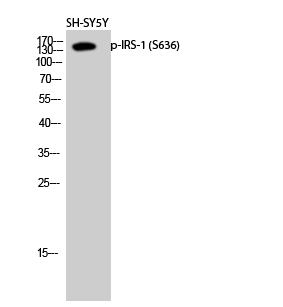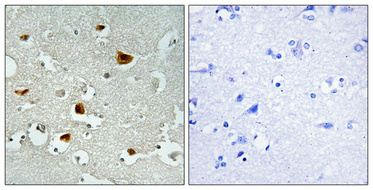

| WB | 咨询技术 | Human,Mouse,Rat |
| IF | 咨询技术 | Human,Mouse,Rat |
| IHC | 1/50-1/100 | Human,Mouse,Rat |
| ICC | 1/50-1/200 | Human,Mouse,Rat |
| FCM | 咨询技术 | Human,Mouse,Rat |
| Elisa | 1/10000 | Human,Mouse,Rat |
| Aliases | IRS1; Insulin receptor substrate 1; IRS-1 |
| Entrez GeneID | 3667 |
| WB Predicted band size | Calculated MW: 132 kDa; Observed MW: 150 kDa |
| Host/Isotype | Rabbit IgG |
| Antibody Type | Primary antibody |
| Storage | Store at 4°C short term. Aliquot and store at -20°C long term. Avoid freeze/thaw cycles. |
| Species Reactivity | Human,Mouse,Rat |
| Immunogen | The antiserum was produced against synthesized peptide derived from human IRS-1 around the phosphorylation site of Ser636. AA range:603-652 |
| Formulation | Purified antibody in PBS with 0.05% sodium azide,0.5%BSA and 50% glycerol. |
+ +
以下是3篇与Phospho-IRS1 (Ser636)抗体相关的参考文献摘要:
1. **"Phosphorylation of IRS1 at Ser636 correlates with insulin resistance in adipocytes"**
*作者:Um SH et al. (2004)*
摘要:研究揭示了高脂饮食诱导的小鼠脂肪细胞中IRS1 Ser636位点的磷酸化水平升高,与胰岛素信号通路受阻及全身性胰岛素抵抗相关,提示该位点磷酸化可作为代谢紊乱的生物标志物。
2. **"mTOR/S6K1 signaling regulates phosphorylation of IRS1 at Ser636"**
*作者:Tzivion G et al. (2008)*
摘要:通过体外激酶实验证明mTOR/S6K1通路直接调控IRS1 Ser636磷酸化,该修饰通过负反馈机制抑制胰岛素受体信号传导,为代谢性疾病治疗靶点提供理论依据。
3. **"Pro-inflammatory cytokines induce IRS1 serine phosphorylation in muscle cells"**
*作者:Boura-Halfon S et al. (2009)*
摘要:在L6肌管细胞中发现TNF-α等炎症因子通过激活JNK激酶导致IRS1 Ser636磷酸化,此修饰与胰岛素刺激的葡萄糖摄取能力下降相关,解释了慢性炎症与胰岛素抵抗的分子关联。
4. **"Distinct roles of IRS1 phosphorylation sites in regulating insulin signaling"**
*作者:Thirone AC et al. (2006)*
摘要:通过位点特异性突变实验比较Ser636与其他磷酸化位点(如Ser307)的功能差异,发现Ser636磷酸化更直接参与胰岛素信号通路的动态平衡调控,而非单纯负反馈作用。
The Phospho-IRS1 (Ser636) antibody is a key tool for studying insulin signaling and metabolic regulation. IRS1 (Insulin Receptor Substrate 1) is a critical adaptor protein that mediates insulin and insulin-like growth factor signaling. Phosphorylation at Ser636 (or Ser639 in some isoforms) is associated with negative regulation of insulin signaling, often linked to insulin resistance in metabolic disorders like type 2 diabetes and obesity. This post-translational modification is induced by stress-activated kinases, including mTOR, JNK, or IKKβ, under conditions such as chronic inflammation, hyperinsulinemia, or nutrient overload.
The antibody specifically detects IRS1 phosphorylated at Ser636. enabling researchers to study this inhibitory modification in cell and tissue samples. It is widely used in Western blotting, immunohistochemistry, and immunofluorescence to assess IRS1 activity status in metabolic studies, particularly in models of diabetes, obesity, or mitochondrial dysfunction. Elevated Ser636 phosphorylation correlates with impaired PI3K/Akt pathway activation, reduced glucose uptake, and disrupted metabolic homeostasis. Researchers also utilize this antibody to evaluate therapeutic interventions targeting insulin resistance mechanisms. Validation typically includes testing in knockout models or phosphatase-treated samples to confirm phosphorylation-dependent specificity.
×